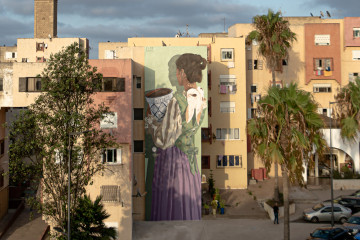

Graffiti and street art have long been an indicator of modernity immersed in a city’s art scene.
Their innovative design makes the neighbourhood look impressive, whether it is futuristic graffiti-writing as the result of an illegal sign of rebellion, or giant, image-based murals painted with permission of the wall’s owner.
The city walls in the Middle East and North Africa are no exception. The capital Rabat hosts an international annual festival, Jidar: Toiles de rue, which is gradually becoming a major event for street art practitioners in the region.
With the participation of street artists from Portugal, Mexico, Italy and Japan, amongst other nationalities, it is organised in the city that is home to one of the very few national museums of modern and contemporary art in the region, the MMVI.
"Between a hip-hop aesthetic and folklorism, street art is a practice as old as time itself in Morocco"
Morocco is not new to forms of expression of a vigorous urban art scene and the alternative culture that includes hip-hop. Authorities encourage street art forms and choose to provide legal venues for artistic expression in the public space.
The very-popular L’Boulevard is an annual urban music festival founded in 1999 in Casablanca by Mohamed Merhari (also known as Momo) and Hicham Bahou. Articulated into three main sections, it comprises the Sbagha Bagha Casablanca Street Art Festival, an initiative that sees graffiti artists cover the "White City" (Casablanca) with their creations.
Both Jidar: Toiles de rue and Sbagha Bagha are mutual art projects – currently Salah Malouli is the artistic director – organised in collaboration with the same non-profit, EAC-L'Boulvart, which supports contemporary music and urban culture in Morocco.
The Casamouja Festival – an event of the programme WeCasablanca – represents another initiative for Moroccan artists who seek a challenge by performing monumental frescos.
Generally painted on building facades, these giant murals do not simply embellish the walls.
Depicting scenes of social-popular inspiration, sometimes with political intent, they are performed even by multiple artists and commissioned by businesses, local organizations, or city officials.
The Moroccan artist Bakr Addaoui, aka BAKR, painted a 150-square-metre mural for the Casamouja Festival, in 2021. Titled Ghost Light, this wall pays tribute to the traditional Moroccan fishermen.
BAKR, a graduate of L’Ecole supérieure des beaux-arts of Casablanca, tried to create a scene where a fisherman is looking for hope and a way to earn a living.
|
It is not just the walls of Casablanca or Rabat that are white. Between a hip-hop aesthetic and folklorism, street art is a practice as old as time itself in Morocco.
In 1978 prominent Moroccan artist Mohamed Melehi (1936-2020) got together with Mohamed Benaissa – who would become the city’s major for a number of years – to launch an annual festival of the arts in the coastal town of Asilah.
Melehi was born in Asilah and was one of the leading members of the nativist modernist Casablanca School Art movement led by L’Ecole supérieure des beaux-arts faculty members in the 1960s. Asilah was celebrated – and still is – for its murals through which every year artists embellish walls perpetrating a tradition.
The town of Azemmour has been put in the limelight too, thanks to the Remp’Arts festival held in 2013, the first truly street art event in Morocco with the participation of international artists. A place of art and history, over the years Azemmour has never ceased to affirm its vocation and its ambition to put culture at the heart of its policy.
The essential artists from the urban art scene in Morocco
BAKR is not alone in his artistic forays across the streets of Morocco. Others are wandering the streets in places such as Rabat, Casablanca, and Marrakesh.
The artist Morran Ben Lahcen is recognised as one of the pioneers of Moroccan street art. His artistic journey began on the streets of a town near Marrakesh, where he was born. He has developed a broad range of artwork ranging from interventions in abandoned structures to exhibitions in museums and galleries.
Tima, Majid Elbahar, Aouina, ED Oner, among others, are pseudonyms attributed to Moroccan artists that reclaim public space with their frescos, sometimes triggering significant discussions, often negotiating with the dwellers.
|
Fatima Ezzahra Khilad, aka Tima, 25, is one of the few Moroccan women who participated in the Jidar: Toiles de rue festival. A graduate of L’Ecole supérieure des beaux-arts of Casablanca, her murals are powerful works that represent odes to the unknown, memory and resistance.
For Jidar22 she painted her mural that appears to have been inspired by the fairy tale commonly known as Alice in Wonderland.
There is a lot of mystery in the small details that leave plenty of room for interpretation. The mural is called HOW LONG IS FOREVER and is meant to symbolise the woman who dreams, who resists, and who tries to be authentic in this world.
For Jidar22 the Moroccan street artist Mohamed Touirs, aka ED Oner, 28, a graphic designer originally from Berrechid, painted his mural which is a reproduction of three images of postage stamps inspired by the city of Rabat, its multi-millennial history and culture: the door of the ancient archaeological site of Chellah, traditional blue boats on the Bou Regreg river, and three famous national football players.
The mural is called Jidar Stamps and is designed in a retro (Moorish) style meant to highlight symbols of Moroccan culture and heritage that arouse a certain nostalgia for times past.
Elisa Pierandrei is an Italian journalist and author based in Milan. She writes and researches stories across art, literature, and visual media.
Follow her on Twitter: @ShotOfWhisky





 Follow the Middle East's top stories in English at The New Arab on Google News
Follow the Middle East's top stories in English at The New Arab on Google News


